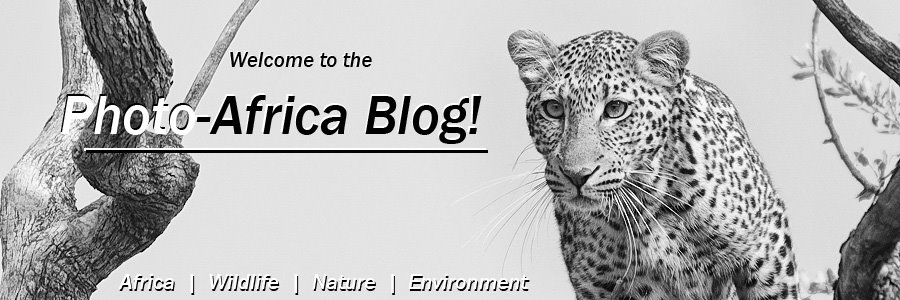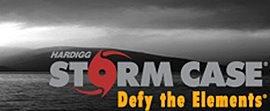Exposure and focus are obviously very important technical skills, but it is composition that gives your image structure and creates a pleasant viewing experience.
Wildlife photography is no exception and in this Blog, which complements a previous Blog called "Lines & Shapes in Wildlife Photography", I have scratched around the images on Photo-Africa to see how composition plays a role in creating striking, interesting, dynamic and when you break the rules, different wildlife images.
Focal Point – What is the focus of your image?
One way to draw your viewer’s attention to your focal subject is to place the subject on a ‘power point’ which is defined by the rule of thirds. To complement this, or as an alternative you could use lines to draw your viewers attention into the frame ending on your planned focal point. The following two examples show how to draw attention to your focal point.
Example 1 – Focal Point
The above image shows much better composition than if Matt were to place the elephant dead centre in the frame. Also, whenever you are about to click the shutter, have a quick look around your subject and see whether there is not some kind of lines or other shapes in the surrounding environment which can assist you in highlighting your focal subject. There are normally many creative ways in which you can highlight the subject that caught your eye in the first place.
Example 2 – Focal Point
In this image the lion is again placed on one of the power points. The viewer’s gaze is again drawn in from the left of the frame by the diagonal line created by the brown road leading towards the big cat.
Active Space – Leave space for your subject to look or move into.
If you are photographing a subject that is looking at something, such as the lion in the above example, or moving in a specific direction you should try and keep some space for them to do so. Two examples of using active space.
If the bat was placed dead center in the frame it would not have been as dynamic.
Example 2 – Active Space
A great action capture. All three impala are clear and moving, and looking, into a specific direction. By leaving space on the right Grant has left space for these three antelope to move towards.
Again, if this image was centered and cropped it would have been a mildly interesting but not as dynamic as it currently is. A quick thought - with this image it might have been an option to place the three impala towards the far right of the frame as this might have made the viewer wonder what was chasing them?
Create Depth – Draw your viewer deeper into the image.
Photograph is a two dimensional representation of three dimensional scene. In order for you to create a realistic representation of what you saw at the time of clicking the shutter you need to try and create some sort of depth in your images. This can be done by playing with different lenses, which gives you different perspectives, or by placing various elements in your frame to support the focal subject and place it within a three dimensional scene.
Example 1 – Create Depth
In this image you get the feeling that the lion is moving towards you. The game drive vehicle in the background is blurred perfectly and along with the diagonal road leading up and away from the lion creates depth in the image.
Great safari image which is more interesting than if the lion was walking towards you on a flat surface and without anything in the background to create a feeling of depth in the image.
Fill the Frame – Get in close, then get even closer!
By filling the frame your viewer cannot make a mistake as to what your focal subject is. You still have to keep composition and placement in mind but by getting in close to your wildlife subject you are on your way to creating a striking image.
This close up of a female lion was shot as is – no cropping. You can almost see the inquisitive nature of this young lioness which would have gone missing was the image not shot full frame.
The placement of the eyes and nose still conforms to the rule of thirds and even creates an diagonal line between them. Good example of how you can fill your frame to create interesting and striking wildlife images. (Also see the Blog "Fill the Frame" on Your Photo Tips)
Cropping – Crop your image for more impact.
If you have even been on safari you must have a few images that you looked at afterwards and thought “this could have been much better”. By cropping some of your images you might find that they have more punch than the original. You can also use cropping to highlight the size of an animal or, if you chopped of an ear of a certain animal, crop both ears and see what you come up with.
Example 1 – Cropping
Now that the elephant almost fills the frame he seems a lot more imposing and a helluva lot bigger. This crop, combined with the fact that image was taken from a low angle, looking up at the animal makes for a great elephant image.
Keep it Simple – Know what to include and leave out.
Every element in your image should highlight and the support the focal subject. A lot of the time we try and add more and more to an image in order to spice it up and make it interesting. Not necessary. A lot of the time it is a plain and simple image that turns into a winner.
You can also see that the red color of the bird’s eye, which has been captured perfectly) is repeated in the little bit of red in the prey that is held in its talons. Very simple image that shows you should keep it simple. Any more colors or objects in the frame would have taken the focus off the bird and dropped the punch-factor of the image.
Other point to keep in mind when thinking about the composition of your image:
- Background – Does it draw attention away from your subject?
- Emotion – What was it that drew your attention in the first place? Shoot with your ‘emotion’ and try to highlight that feeling in the image.
- Numbers – Odd numbers are visually more exciting. Triangles, odd number of side, also make more dynamic image.
- Study – View other photographers work and see how they approached the scene they were photographing.
- Be Yourself – Don’t try and mimic someone else’s images. Do your own work and don’t be afraid of experimenting.
- Shoot – Really work every subject and try to use different angles and lenses.
If I find the time I would also like to do a Blog on Exposure in Wildlife Photography, a slightly more technical one, so will see how that goes.
Make sure to check back from Friday when I will upload this week’s High Five.
As always I look forward to hearing your comments!
Gerry
.jpg)























4 comments:
Great post and I really like the picture of the lions face. Great detail!
Holy cow!! that was on tip packed post!!
Gerry, I was in Kenya many years ago (coming up to 10 years now!).
I LOVED it - it was the best holiday I ever had.
This was before I got into photography.
I'll definitely be reading over this article again before I next go to Africa!
You have some amazing images by the way.
CHeers.
Great read and tips Gerry and nice set of example photos, you should label your tips for easy reference, your tips are something I will look over again and again.
Post a Comment